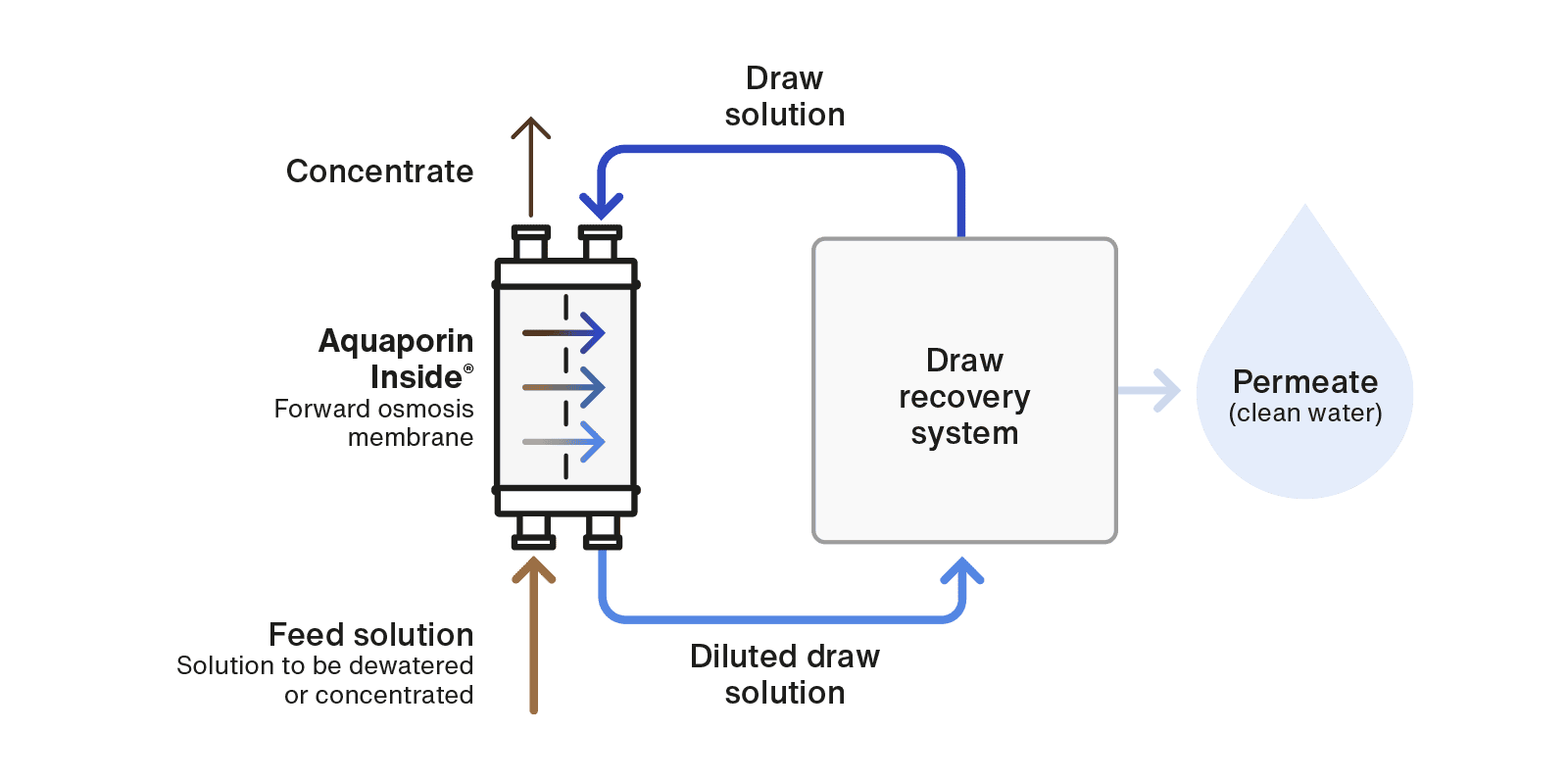The forward osmosis process is increasingly being used in water treatment applications, from food and beverage production to heavy industry. Here you will find answers to the common questions about the osmosis process.
What is forward osmosis?
Forward osmosis (FO) is a water separation process which uses a semipermeable membrane and the natural energy of osmotic pressure to separate water from dissolved solutes. The osmotic pressure is used to transport water through the membrane while retaining all the dissolved solutes on the other side.
This extremely effective filtration process, which ensures that only pure water is extracted from the feed solution, makes forward osmosis technology useful for several types of industrial water treatment applications, such as wastewater management, product concentration, and water recycling. Since it relies on the natural energy of osmotic pressure, it is also a less energy-intensive method than other hydraulic pressure-based water treatment technologies.
Forward osmosis can correctly be called simply “osmosis”. However, in an industrial water treatment context, it is normally referred to as forward osmosis to distinguish it from reverse osmosis, another method for membrane-based water treatment commonly used for industrial effluent processing using hydraulic pressure as driving force. For more details on the difference between forward osmosis and reverse osmosis, click here.
How does forward osmosis work?
In a forward osmosis system, a feed solution such as industrial wastewater flows on one side of the water membrane, while a draw solution with a higher total dissolved salinity (TDS) flows on the other side. The difference in TDS between the two sides creates osmotic pressure which induces water to flow from the feed solution through the membrane and into the draw solution while retaining all the contaminants in the feed stream.
As the water moves through the membrane, the draw solution becomes diluted, and the feed solution is concentrated, thus producing concentrated effluent. The entire process can be run without additional hydraulic pressure. The draw solution can consist of a simple salt/water mix or a substance specifically tailored for the application.
What can forward osmosis be used for?
Forward osmosis is generally used for three types of industrial applications:
- Product concentration: Forward osmosis can be used to extract water from liquid products, leaving a valuable concentrate. For example, forward osmosis can be used to concentrate food & beverage products such as coffee, beer or coconut water. This allows for products to be stored, handled, and shipped with much greater ease and significant logistics cost reductions. It can also be used to develop new products. Because forward osmosis is a gentler concentration method than alternatives like thermal or pressure-based concentration, the risk of damaging volatile flavors and aromas is greatly reduced and the product retains most of its original qualities and taste when reconstituted.
- Wastewater concentration: In most industrial facilities, forward osmosis can be used as part of the wastewater treatment process to extract water from the effluent stream, leaving a concentrated waste product that is easy to dispose of. This is a significant benefit when running a Zero Liquid Discharge waste disposal, as it leaves much less water for the evaporators to remove, thereby reducing energy use. The extracted water can be recycled back into the production process or reused for other purposes.
- Extracting clean water for reuse: In both product concentration and wastewater concentration, forward osmosis moves water from the feed solution into the draw solution. This water can then be recovered to produce clean water using a draw solution regeneration step such as reverse osmosis. Permeate from the draw regeneration step is of high quality as it is separated from the forward osmosis feed stream via a two-layer membrane. The purity of the permeate depends on the rejection features of the forward osmosis and reverse osmosis membrane. Depending on the characteristics of the effluent stream and the effectiveness of the entire treatment train, the extracted permeate can be reused for purposes such as cooling, rinsing or even irrigation and drinking water.
What is the difference between forward osmosis and reverse osmosis?
Like reverse osmosis (RO), forward osmosis is a membrane water treatment solution. The main difference between reverse osmosis and forward osmosis is how water is driven through the membrane. In reverse osmosis, the water is forced through the membrane using hydraulic pressure. Forward osmosis uses natural osmotic pressure to induce the flow of water through the membrane. Operation at low hydraulic pressure allows the forward osmosis process to be robust against fouling and mitigating compaction of fouling materials on the membrane surface.
What is a ‘forward osmosis solution’?
A forward osmosis solution employs a draw recovery system to separate the clean water from the used draw solution. The diluted draw solution is then re-circulated back to the forward osmosis step to continuously extract water from the feed stream.
In forward osmosis, the water molecules are drawn from the feed solution into the draw solution. In order to produce clean water and recover the draw solution for reuse, the two need to be separated using another type of water treatment system – a draw recovery system. The draw recovery system can be based on either evaporation, membrane-based (typically RO) or thermo-responsive draw solutes.
The main components of a forward osmosis solution are:
The forward osmosis membrane
The forward osmosis membrane allows water to pass but prevents other substances from permeating. The efficiency with which it performs the latter task is known as the rejection rate. A high rejection rate and robustness against fouling, withstanding elevated levels of Chemical Oxygen Demand (COD) and Total Organic Carbon (TOC) – are key qualities of an effective FO membrane. The membrane must also keep reverse flux to a minimum, allowing as little solute from the draw solution as possible to diffuse across the membrane into the feed solution.
The draw solution
The highly saline draw solution creates the osmotic pressure difference which induces water to flow from the feed solution through the membrane. To achieve optimal results, the draw solution must be precisely formulated to match the composition of the effluent. As the water moves through the membrane and the feed solution is concentrated, the draw solution becomes diluted and ultimately ineffective unless it is reconcentrated in a draw recovery system.
The draw recovery system
The role of the draw recovery system is to restore the Total Dissolved Solids (TDS) concentration of the draw solution and extract clean water for reuse. This is usually accomplished through a conventional sea water reverse osmosis system designed to handle TDS up to 60,000 to 70,000 parts per million (ppm). In some cases, novel draw regeneration processes can be employed, handling up to 250,000 ppm TDS. Depending on the setup of the specific site, the clean permeate can be reused for cooling, rinsing and other wet processes. What's more, if the forward osmosis process is designed to sufficiently high standards, it even becomes possible to recycle the water for use in upstream processes, such as mixing dyes in textile production.
If you are interested in trying out a forward osmosis solution, Aquaporin's mobile lab unit, ESSENCE go, offers flexible testing for a wide range of products.
How does forward osmosis contribute to zero liquid discharge (ZLD) or minimal liquid discharge (MLD)?
When it comes to ZLD or MLD, FO can be integrated into water treatment systems to improve recovery rates and reduce the energy required for evaporation.
For effluent treatment plants, for example, the ultrafiltration (UF)/nanofiltration (NF) stage can be fully or partly replaced by FO (option 1 and 2). This can simplify the treatment process, increase system robustness when dealing with challenging contaminants, and increase the amount of water sent for reuse. FO can also be added after RO (option 3) to further reduce the volume sent to the evaporator and so reduce operating expenses.

These ZLD/MLD systems are becoming more efficient. For instance, Canadian company Forward Water has created a water treatment system that cleans flow back water and produced water from the oil & gas industry with very little energy required for evaporation. This is achieved using a unique draw solution that converts into gas with just a small amount of heat, such as secondary heat from an existing industrial process.
In water-stressed regions like India, where regulation makes the use of ZLD mandatory to address water scarcity and pollution, there is a growing interest in implementing forward osmosis in industrial wastewater treatment processes.
What about reverse flux / reverse transfer?
Like all semipermeable membranes, some solute from the draw solution can diffuse back through the membrane into the feed solution. This is known as reverse flux or reverse transfer and has to be considered when designing a forward osmosis application. Reverse flux is influenced by the choice of draw solution and membrane. The best forward osmosis membranes keep the reverse flux to a minimum in order to minimize draw solute top-up cost in operation.
If you're curious to learn more about forward osmosis and how it can benefit your business, book a meeting with one of our experts here.



